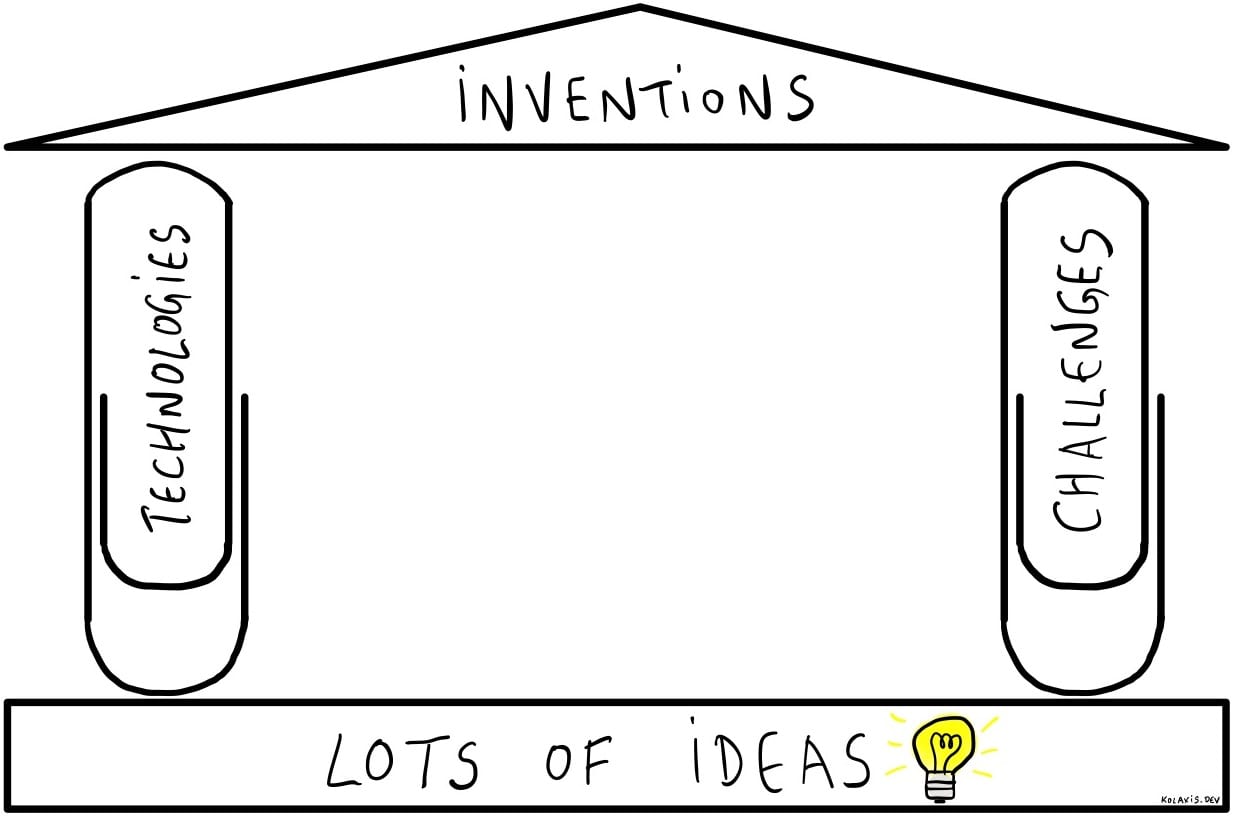How would our lives look like without inventions, such as electricity, computers & the internet?
Here I share my experience of how I came up with my first 2 inventions, hoping that I can help fellow engineers to unleash their potential and design novel technical solutions, the inventions of tomorrow that will positively transform the way we all live and work.
The key to inventing: Having lots of ideas!
The more ideas you have, the more likely it is that you will eventually invent something.
If you expect that your very first idea will be a successful invention, then you will probably be disappointed when you find out that your idea did not make it. There can be many reasons that an idea does not qualify as an invention, with the most common ones being:
- There are already existing inventions that are similar or even identical to your idea (also known as “prior art”),
- Your idea may be obvious, lacking the so-called “inventive step”; if a skilled person (like a colleague) were asked how they could solve your problem, then they would likely propose the same solution as you did.
- It may not be technically feasible to have your idea implemented, with the idea being somewhere in the sphere of science fiction. My first idea did not qualify as an invention. My second idea did not make it either. I had to come up with 14 ideas in a year until 2 of them qualified as inventions!
The process of inventing can be like an emotional roller coaster: feeling disappointed whenever an idea of yours fails and feeling excited when your idea finally makes it as an invention. Most of the time, most of your ideas will fail, hence making it likely for disappointment to prevail. What helped me overcome this and succeed was that I aimed to maximize my failures; the more ideas of mine failed, the more confident I was about getting closer to my goal of conceiving an invention.
When I started my journey, I did not have 14 ideas, but I had only 1 idea. What proved to be quite beneficial was the research I had to do to elaborate on each idea, as it provided me with the insight and inspiration that enabled me to conceive my next big idea.
Testing your ability to invent

How many uses can you think of for a paper clip?
Try to resist the temptation of searching this on Google and see how many uses you can find! As a starting point, we can use a paper clip to:
- Reset a router to factory default settings,
- Change the SIM card of an iPhone,
- Manually eject a CD/DVD from an older computer,
- …
Most people might find 10 to 15 uses for a paper clip, whereas a few people who are good at this will come up with around 200! According to Sir Ken Robinson, this test examines our ability to see lots of possible answers to a question, lots of possible ways of interpreting a question, an ability that is known as divergent thinking. This ability is considered essential for coming up with original ideas that have value.
From my experience, inventing is indeed a similar exercise to the one with the paper clip. Still, inventing can be harder because you first need to find the right question(s) and next attempt to come up with many different answers, one of which could be the invention you have been looking for. In my quest for inventions, I found it helpful to ask questions focused on a specific technology or challenge.
Inventing with a focus on technologies
How many uses can you think of for blockchain?
This is the question I had asked myself when I came up with an idea of how blockchain can be used in an unusual way that wasn’t previously thought of; this was my first invention.
Now it’s time for you, an aspiring inventor, to try this by answering the following similar question: How many uses can you think of for “technology X”?
“Technology X” can be any technology, usually a new one that may solve existing problems in a unique, novel way that wasn’t possible with older technologies.
You don’t necessarily have to master this new technology; I did not have any professional experience using blockchain, just had a curiosity to learn what it is and how it works. In my experience, a fresh look at a technology you are not familiar with can help you come up with unusual ways of solving problems. On the contrary, our thinking tends to become more conventional with technologies we have already mastered, as to what the established uses of these technologies are.
Inventing with a focus on challenges
How many solutions can you think of for “challenge Y”?
When I first started working remotely, I began to face some challenges that I didn’t have while working from the company’s office. That’s what triggered my search for solutions to these challenges, solutions that would empower every remote worker to work more effectively. This is how I came up with my second invention.
Don’t let the challenges around you go by. Every challenge you face is an opportunity for you to invent! As the saying goes: “Necessity is the mother of invention.”
A mental model for inventions
My experience inventing has led me to create the following mental model for inventions:

Every invention stands on 2 pillars: Challenges and Technologies.
In my search for patents, it helped me to focus on one pillar at a time, applying divergent thinking by asking the questions explained earlier. I prefer to concentrate on challenges, as I see a higher value in inventions that do solve actual problems. On the contrary, when focusing on technologies, we run the risk of inventing for the sake of technology without addressing any actual challenges. Still, every invention attempts to solve a challenge (hopefully a real one, not imaginary!) by using one or more technologies, hence the 2 pillars.
Ideas form the foundation of inventions. Every successful invention is founded on many unsuccessful ideas that essentially taught you things you didn’t know of, thus helping you reach your destination of conceiving a novel idea, an invention.
Reinventing our world, one invention at a time
My inventions are not as big as electricity, computers, and the internet; your inventions may not be either! However, each invention is a step forward in evolving our existing technical solutions. If each one of us contributes at least one invention, then the sum of our inventions can help us build the next big thing that can transform how we all live and work.
Further reading
-
The inspiring story of how one of the greatest inventors of our times, Thomas A. Edison, established and ran his Invention Factory: https://edison.rutgers.edu/life-of-edison/biographical-essays/the-invention-factory
-
The fun fact of how a product & a company were both named after the 40 attempts that their inventor had to make until the successful discovery of a Water Displacement formula: https://www.wd40.com/history/
-
The presentation given by Sir Ken Robinson that provides more information about the paper clip test: “Changing Education Paradigms”, RSA ANIMATE: https://www.youtube.com/watch?v=zDZFcDGpL4U

